stop start TOYOTA HIGHLANDER 2017 XU50 / 3.G Quick Reference Guide
[x] Cancel search | Manufacturer: TOYOTA, Model Year: 2017, Model line: HIGHLANDER, Model: TOYOTA HIGHLANDER 2017 XU50 / 3.GPages: 56, PDF Size: 3.78 MB
Page 19 of 56
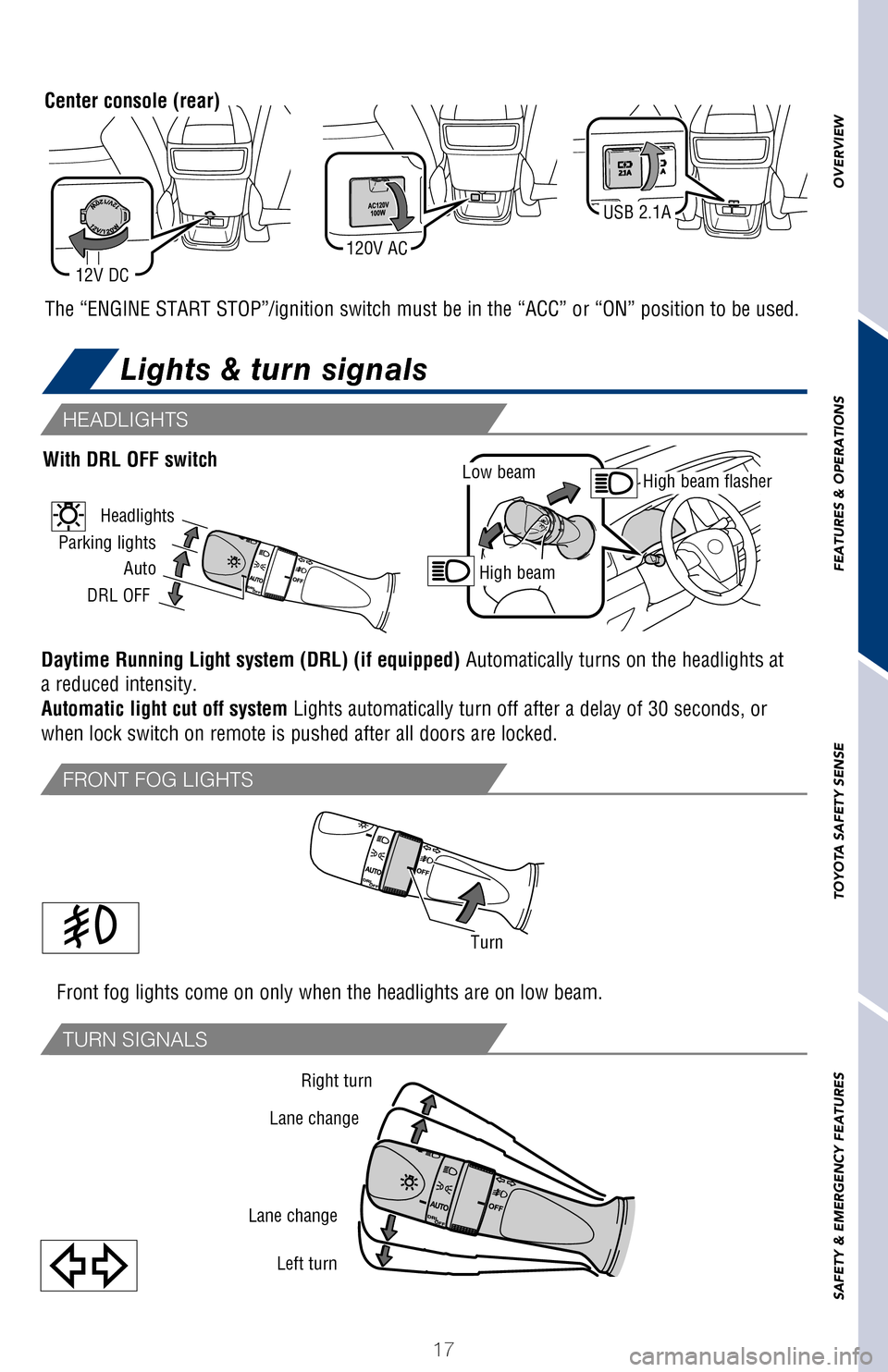
OVERVIEW
FEATURES & OPERATIONS
TOYOTA SAFETY SENSE
SAFETY & EMERGENCY FEATURES
17
The “ENGINE START STOP”/ignition switch must be in the “ACC”\
or “ON” position to be used.
2 Rain-sensing windshield wipers
Rotate to increase/decrease sensor
sensitivity. (if equipped)
Center console (rear)
Front fog lights come on only when the headlights are on low beam.
Daytime Running Light system (DRL) (if equipped) Automatically turns on the headlights at
a reduced intensity. Automatic light cut off system Lights automatically turn off after a delay of 30 seconds, or
when lock switch on remote is pushed after all doors are locked.
Low beam
High beam
High beam flasher
Parking lights
Auto
DRL OFF
With DRL OFF switch
Headlights
Turn
Right turn
Lane change
Lane change Left turn
120V AC
12V DC
USB 2.1A
Note: USB 2.1A for charging devices only.
Lights & turn signals
HEADLIGHTS
FRONT FOG LIGHTS
TURN SIGNALS
Windshield wipers & washers
Power outlets-
12V DC/120V AC/USB 2.1A (
if equipped)
2017_Highlander_QRG_V1_1.indd 1711/22/16 11:29 PM
Page 20 of 56
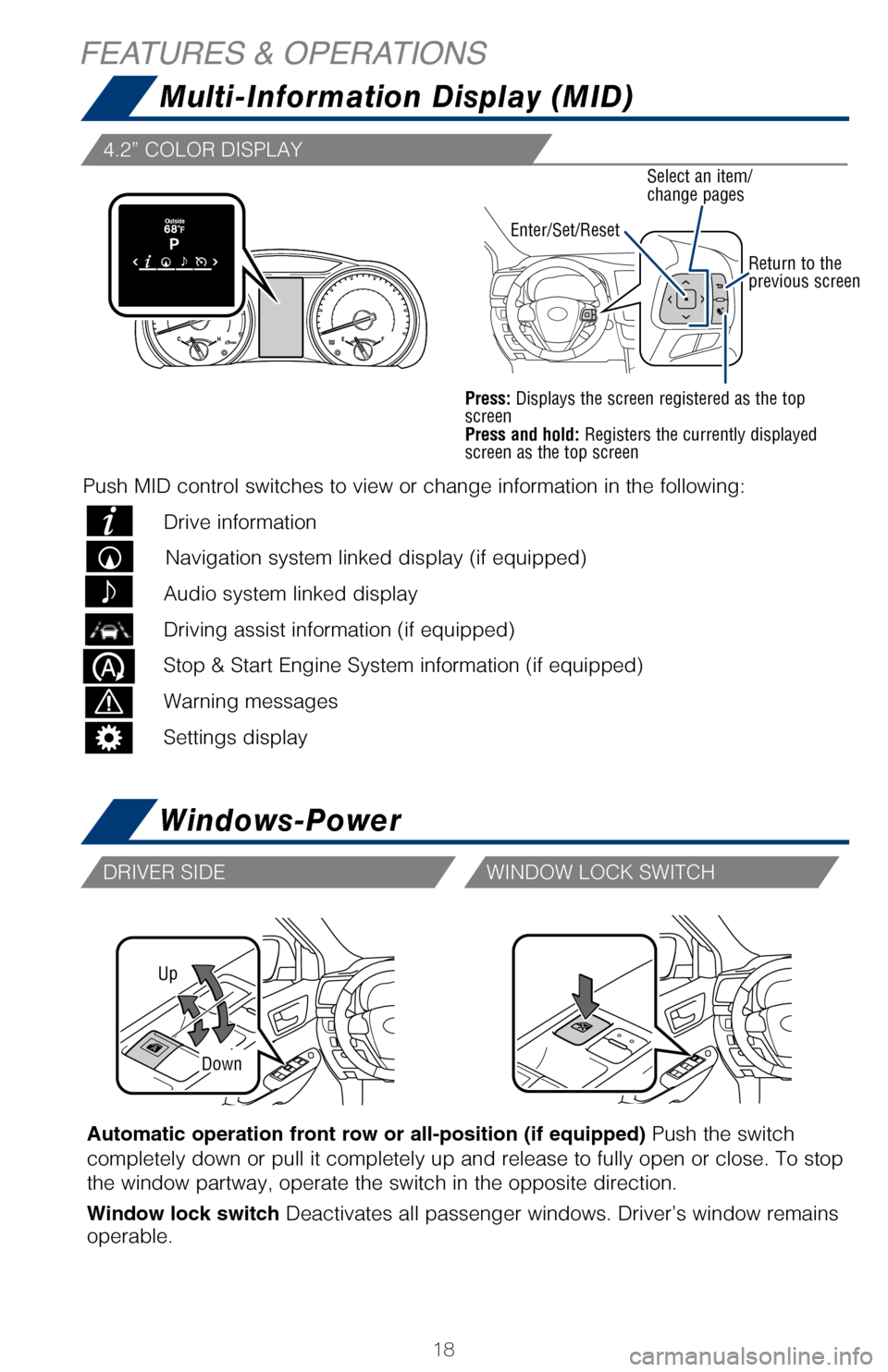
18
Up
Down
Automatic operation front row or all-position (if equipped) Push the switch
completely down or pull it completely up and release to fully open or cl\
ose. To stop
the window partway, operate the switch in the opposite direction.
Window lock switch Deactivates all passenger windows. Driver’s window remains
operable.
Steering wheel telephone controls
Bluetooth
® technology allows dialing or receipt of calls without taking hands from\
the steering wheel or using a cable to connect the compatible telephone \
and
the system. Refer to “Bluetooth
® Device Pairing Section,” in this guide, for more
information about phone connections and compatibility.
* Position of buttons may vary on some vehicles, for more details please\
refer to the
Owner’s Manual.
The Stop & Start Engine System stops and restarts the engine according
to the brake pedal operation and other operations when the
vehicle is stopped.
Stopping the engine
While driving with the shift lever
in D, depress the brake pedal,
and stop the vehicle.
Disabling the Stop & Start Engine
System
Press the Stop & Start Engine System
cancel switch to disable the system.
DRIVER SIDE WINDOW LOCK SWITCH
If the engine is stopped by the Stop & Start Engine System when the vehi\
cle is
on an incline, brake force is temporarily maintained to prevent rolling
backwards until the engine is restarted and drive force is generated.
When drive force is generated, the maintained brake force is automatical\
ly
canceled.
HILL-START ASSIST CONTROL (HAC)
Volume control
Enter/Set/ResetSelect an item/
change pages
Return to the
previous screen
Press: Displays the screen registered as the top
screen
Press and hold: Registers the currently displayed
screen as the top screen
Multi-Information Display (MID)
Windows-Power
FEATURES & OPERATIONS
4.2” COLOR DISPLAY
Push MID control switches to view or change information in the following\
:
Drive information
Navigation system linked display (if equipped)
Audio system linked display
Driving assist information (if equipped)
Stop & Start Engine System information (if equipped)
Warning messages
Settings display
2017_Highlander_QRG_V1_1.indd 1811/22/16 11:29 PM
Page 21 of 56
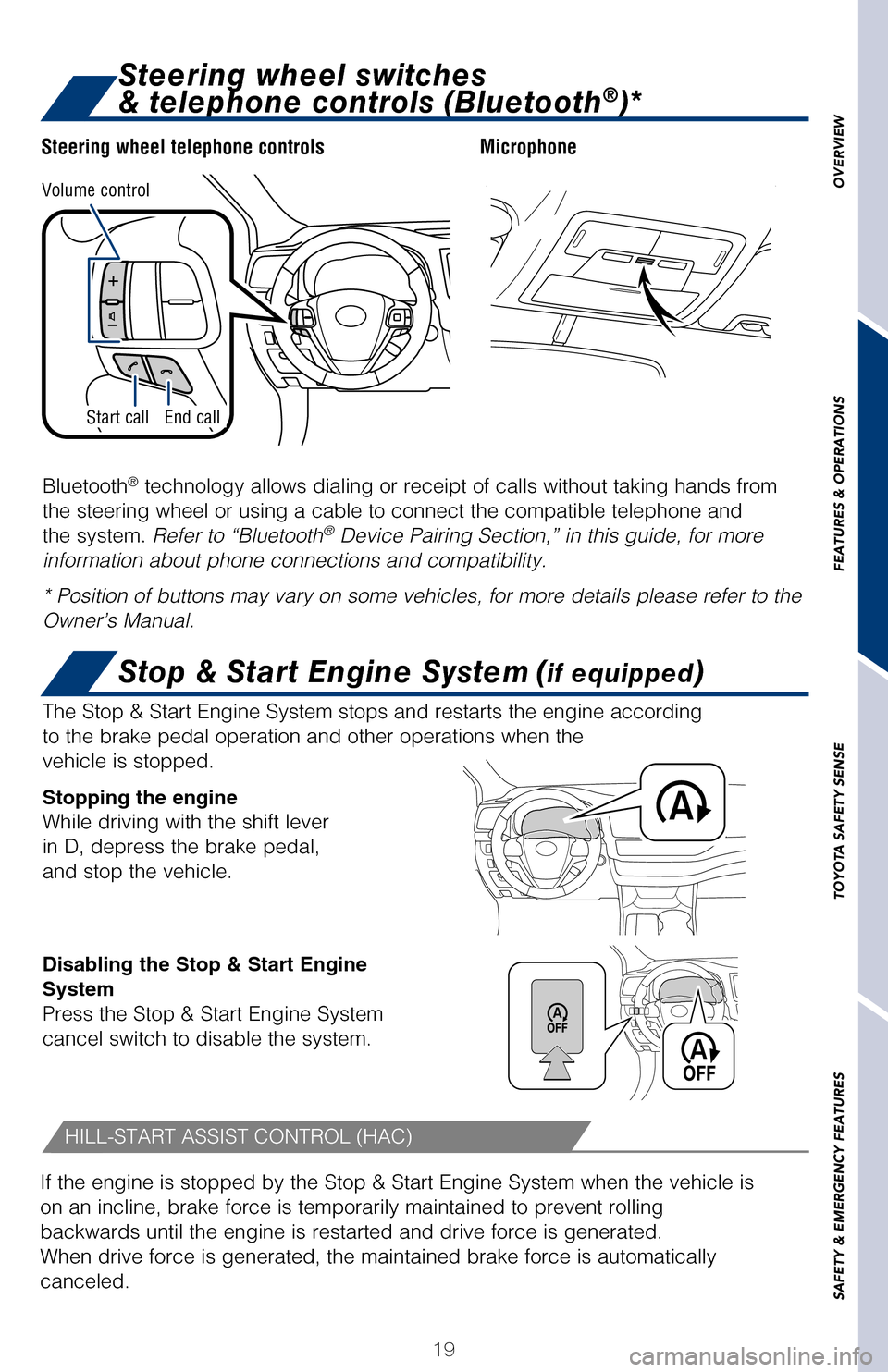
OVERVIEW
FEATURES & OPERATIONS
TOYOTA SAFETY SENSE
SAFETY & EMERGENCY FEATURES
19
Automatic operation front row or all-position (if equipped) Push the switch
completely down or pull it completely up and release to fully open or close. To st\
op
the window partway, operate the switch in the opposite direction.
Window lock switch Deactivates all passenger windows. Driver’s window remains
operable.
MicrophoneSteering wheel telephone controls
Bluetooth
® technology allows dialing or receipt of calls without taking hands from\
the steering wheel or using a cable to connect the compatible telephone and\
the system. Refer to “Bluetooth
® Device Pairing Section,” in this guide, for more
information about phone connections and compatibility.
* Position of buttons may vary on some vehicles, for more details please \
refer to the
Owner’s Manual.
The Stop & Start Engine System stops and restarts the engine according
to the brake pedal operation and other operations when the
vehicle is stopped.
Stopping the engine
While driving with the shift lever
in D, depress the brake pedal,
and stop the vehicle.
Disabling the Stop & Start Engine
System
Press the Stop & Start Engine System
cancel switch to disable the system.
WINDOW LOCK SWITCH
Stop & Start Engine System (if equipped)
If the engine is stopped by the Stop & Start Engine System when the vehicl\
e is
on an incline, brake force is temporarily maintained to prevent rolling
backwards until the engine is restarted and drive force is generated.
When drive force is generated, the maintained brake force is automatically
canceled.
HILL-START ASSIST CONTROL (HAC)
Volume control
Return to the previous screen
Press: Displays the screen registered as the top
screen
Press and hold: Registers the currently displayed
screen as the top screen
End callStart call
Multi-Information Display (MID)
Windows-Power
Steering wheel switches
& telephone controls (Bluetooth®)*
Push MID control switches to view or change information in the following:
Drive information
Navigation system linked display (if equipped)
Audio system linked display
Driving assist information (if equipped)
Stop & Start Engine System information (if equipped)
Warning messages
Settings display
2017_Highlander_QRG_V1_1.indd 1911/22/16 11:29 PM
Page 40 of 56
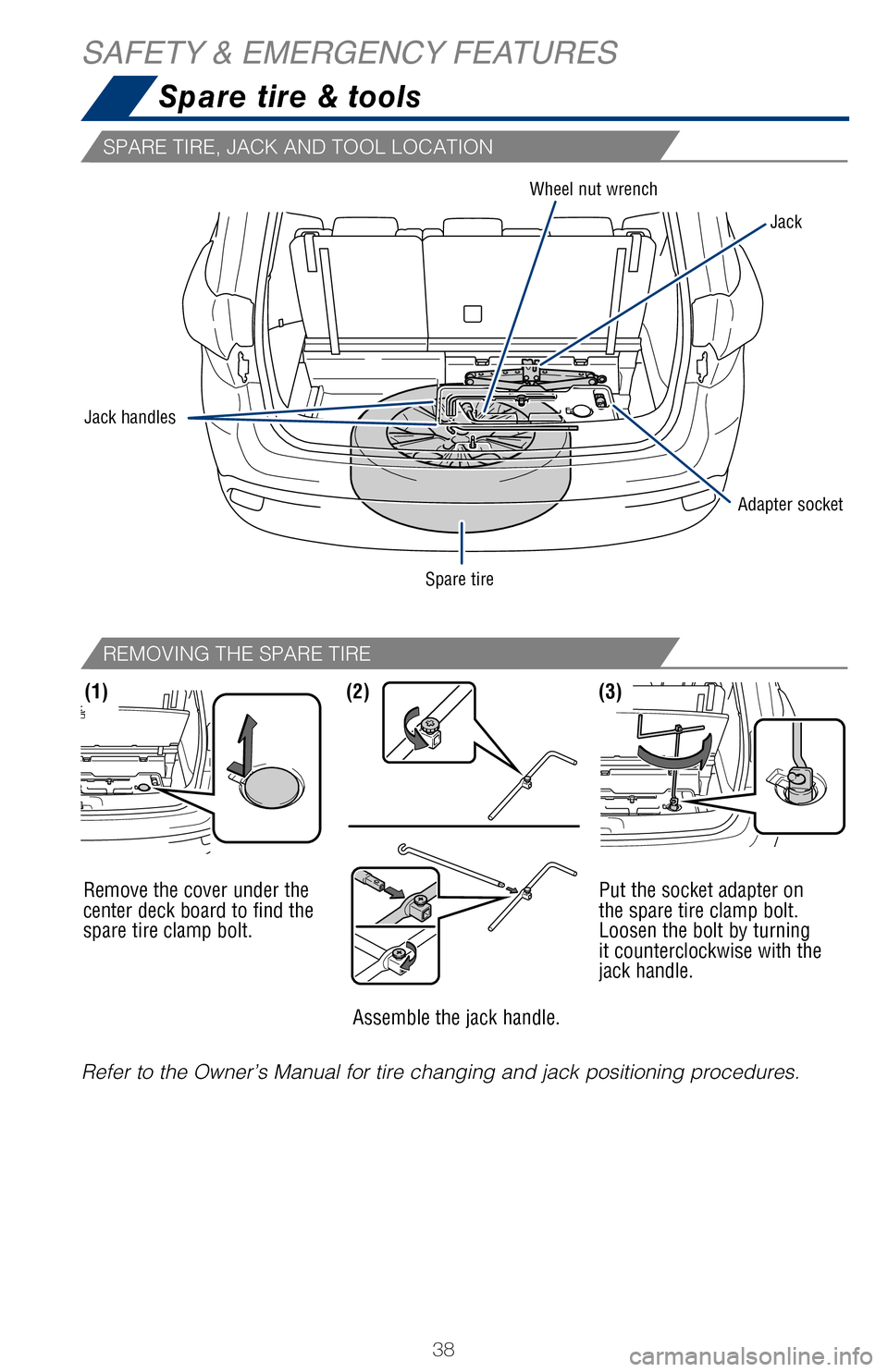
38
Refer to the Owner’s Manual for tire changing and jack positioning pr\
ocedures.Remove the cover under the
center deck board to find the
spare tire clamp bolt.
Assemble the jack handle.Put the socket adapter on
the spare tire clamp bolt.
Loosen the bolt by turning
it counterclockwise with the
jack handle.
(1)(3)(2)
SPARE TIRE, JACK AND TOOL LOCATION
REMOVING THE SPARE TIRE
Spare tire & tools
SAFETY & EMERGENCY FEATURES
Adapter socket
Jack handles Wheel nut wrench
Jack
Spare tire
Smart Stop Technology® automatically reduces engine power when the accelerator
and brake pedals are pressed simultaneously under certain conditions.
SST engages when the accelerator is depressed first and the brakes are a\
pplied
firmly for longer than one-half second at speeds greater than five miles\
per hour.
SST doesn’t engage if the brake pedal is depressed before the acceler\
ator pedal,
allowing vehicles to start on a steep hill and safely accelerate without\
rolling
backward. VSC helps prevent loss of traction during cornering by reducing engine p\
ower and
applying brake force to selected wheels.
Toyota’s VSC monitors steering angle and the direction your vehicle i\
s traveling.
When it senses that the front or rear wheels begin to lose traction, VSC\
reduces
engine power and applies braking to selected wheels. This helps restore \
traction
and vehicle control.
Toyota’s ABS sensors detect which wheels are locking up and limits wh\
eel lockup
by “pulsing” each wheel’s brakes independently. Pulsing release\
s brake pressure
repeatedly for fractions of a second. This helps the tires attain the tr\
action that
current road conditions will allow, helping you to stay in directional c\
ontrol.
Brake Assist is designed to detect sudden or “panic” braking, and \
then add braking
pressure to decrease the vehicle’s stopping distance. When there’s\
only a split
second to react, Brake Assist can add additional brake pressure more qui\
ckly than
just the driver alone can. Helps to maintain drive power and prevent the 4 wheels from spinning whe\
n starting
the vehicle or accelerating on slippery roads.
Toyota’s ABS technology has Electronic Brake-force Distribution (EBD\
) to help
maintain stability and balance when braking. Abrupt stops cause the vehi\
cle to tilt
forward, reducing the braking power of the rear wheels. EBD responds to \
sudden
stops by redistributing brake force to maximize the braking effectivenes\
s of all four
wheels. All new Toyota vehicles come standard with the Star Safety System
TM, which
combines Vehicle Stability Control (VSC), Traction Control (TRAC), A\
nti-lock Brake
System (ABS), Electronic Brake-force Distribution (EBD), Brake Assis\
t (BA) and
Smart Stop Technology (SST).
Refer to the Owner’s Manual for more details and important information on limitations
to these systems.
VEHICLE STABILITY CONTROL (VSC)
ACTIVE TRACTION CONTROL (A-TRAC)
MULTI-TERRAIN ANTI-LOCK BRAKE SYSTEM (ABS)
ELECTRONIC BRAKE FORCE DISTRIBUTION (EBD)
BRAKE ASSIST (BA)
SMART STOP TECHNOLOGY® (SST)
2017_Highlander_QRG_V1_1.indd 3811/22/16 11:29 PM
Page 41 of 56
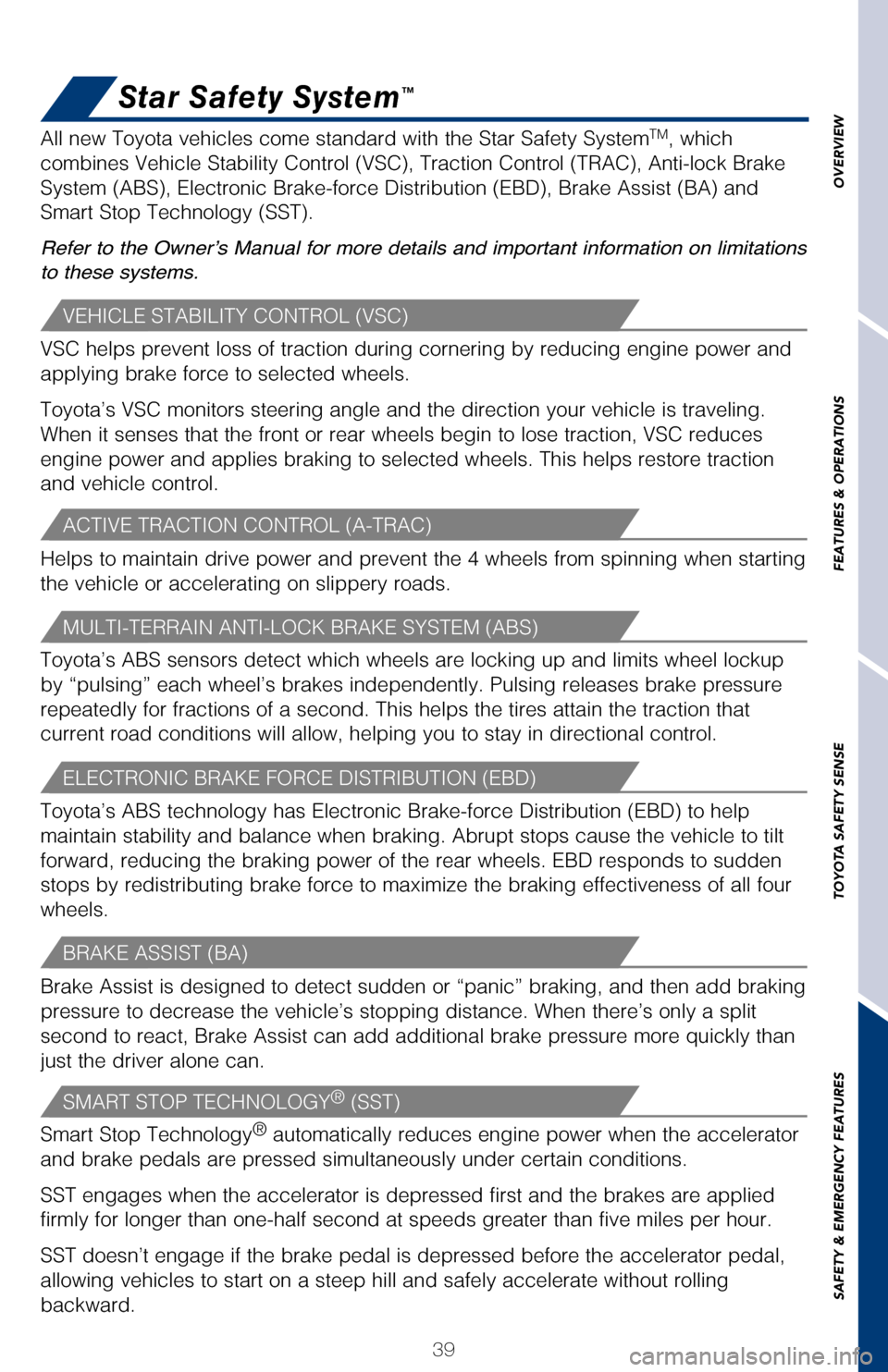
39
OVERVIEW
FEATURES & OPERATIONS
TOYOTA SAFETY SENSE
SAFETY & EMERGENCY FEATURES
Refer to the Owner’s Manual for tire changing and jack positioning pr\
ocedures. Put the socket adapter on
the spare tire clamp bolt.
Loosen the bolt by turning
it counterclockwise with the
jack handle.
Spare tire & tools
Adapter socketJack
Star Safety System™
Smart Stop Technology® automatically reduces engine power when the accelerator
and brake pedals are pressed simultaneously under certain conditions.
SST engages when the accelerator is depressed first and the brakes are a\
pplied
firmly for longer than one-half second at speeds greater than five miles\
per hour.
SST doesn’t engage if the brake pedal is depressed before the acceler\
ator pedal,
allowing vehicles to start on a steep hill and safely accelerate without\
rolling
backward. VSC helps prevent loss of traction during cornering by reducing engine p\
ower and
applying brake force to selected wheels.
Toyota’s VSC monitors steering angle and the direction your vehicle i\
s traveling.
When it senses that the front or rear wheels begin to lose traction, VSC\
reduces
engine power and applies braking to selected wheels. This helps restore \
traction
and vehicle control.
Toyota’s ABS sensors detect which wheels are locking up and limits wh\
eel lockup
by “pulsing” each wheel’s brakes independently. Pulsing release\
s brake pressure
repeatedly for fractions of a second. This helps the tires attain the tr\
action that
current road conditions will allow, helping you to stay in directional c\
ontrol.
Brake Assist is designed to detect sudden or “panic” braking, and \
then add braking
pressure to decrease the vehicle’s stopping distance. When there’s\
only a split
second to react, Brake Assist can add additional brake pressure more qui\
ckly than
just the driver alone can. Helps to maintain drive power and prevent the 4 wheels from spinning whe\
n starting
the vehicle or accelerating on slippery roads.
Toyota’s ABS technology has Electronic Brake-force Distribution (EBD\
) to help
maintain stability and balance when braking. Abrupt stops cause the vehi\
cle to tilt
forward, reducing the braking power of the rear wheels. EBD responds to \
sudden
stops by redistributing brake force to maximize the braking effectivenes\
s of all four
wheels. All new Toyota vehicles come standard with the Star Safety System
TM, which
combines Vehicle Stability Control (VSC), Traction Control (TRAC), A\
nti-lock Brake
System (ABS), Electronic Brake-force Distribution (EBD), Brake Assis\
t (BA) and
Smart Stop Technology (SST).
Refer to the Owner’s Manual for more details and important information on limitations
to these systems.
VEHICLE STABILITY CONTROL (VSC)
ACTIVE TRACTION CONTROL (A-TRAC)
MULTI-TERRAIN ANTI-LOCK BRAKE SYSTEM (ABS)
ELECTRONIC BRAKE FORCE DISTRIBUTION (EBD)
BRAKE ASSIST (BA)
SMART STOP TECHNOLOGY® (SST)
2017_Highlander_QRG_V1_1.indd 3911/22/16 11:29 PM